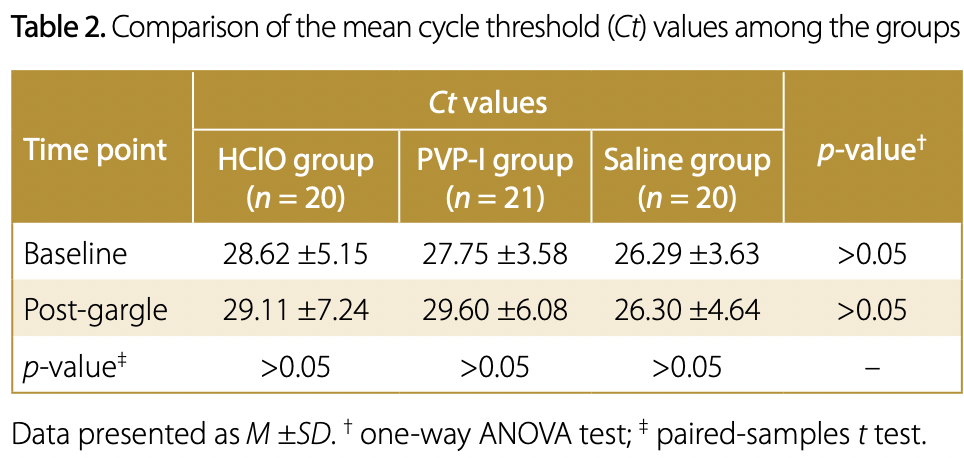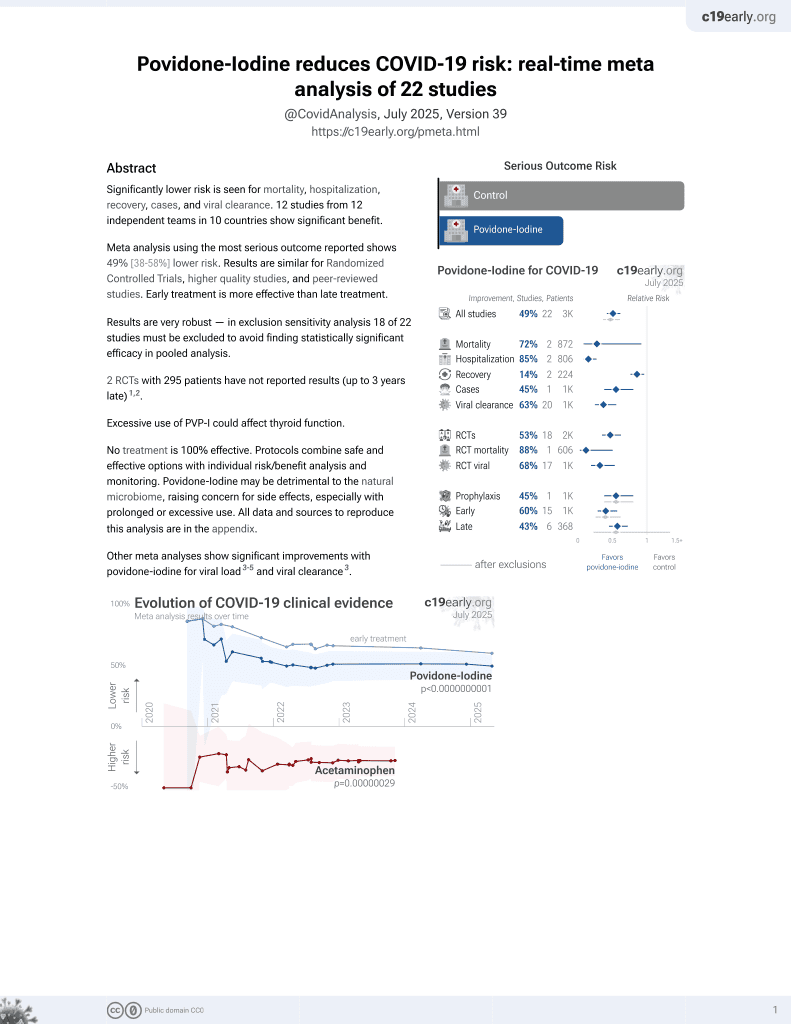
Effect of oral antiseptics on the viral load of SARS-CoV-2: A randomized controlled trial
et al., Dental and Medical Problems, doi:10.17219/dmp/150831, NCT05214196, Jul 2022
PVP-I for COVID-19
14th treatment shown to reduce risk in
February 2021, now with p = 0.000000000016 from 22 studies.
No treatment is 100% effective. Protocols
combine treatments.
6,300+ studies for
210+ treatments. c19early.org
|
RCT with 21 PVP-I, 20 HOCl, and 20 saline patients gargling for 30 seconds and testing PCR Ct after 30 minutes, showing greater improvement with PVP-I and HOCl, without statistical significance.
Ct values differ across testing platforms, however the reported Ct value difference can represent a large difference in viral load. For example, using the calibration included with the ct2vl converter, the reported difference in mean Ct values corresponds to a reduction in viral load of over 3x for PVP-I.
Analysis of short-term changes in viral load using PCR may not detect
effective treatments because PCR is unable to differentiate between intact
infectious virus and non-infectious or destroyed virus particles. For example
Tarragó-Gil, Alemany perform RCTs with cetylpyridinium chloride
(CPC) mouthwash that show no difference in PCR viral load, however there was
significantly increased detection of SARS-CoV-2 nucleocapsid protein,
indicating viral lysis. CPC inactivates SARS-CoV-2 by degrading its membrane,
exposing the nucleocapsid of the virus. To better estimate changes in viral
load and infectivity, methods like viral culture that can
differentiate intact vs. degraded virus are preferred.
This study is excluded in the after exclusion results of meta
analysis:
study only provides short-term viral load results.
Study covers povidone-iodine and hypochlorous acid.
|
risk of viral load, 99.5% lower, RR 0.005, p = 0.37, treatment mean 1.85 (±7.06) n=21, control mean 0.01 (±5.89) n=20, relative improvement in Ct value.
|
|
risk of no viral clearance, 19.0% lower, RR 0.81, p = 0.11, treatment 17 of 21 (81.0%), control 20 of 20 (100.0%), NNT 5.2.
|
| Effect extraction follows pre-specified rules prioritizing more serious outcomes. Submit updates |
Sevinç Gül et al., 29 Jul 2022, Randomized Controlled Trial, Turkey, peer-reviewed, 4 authors, study period 1 September, 2021 - 1 December, 2021, this trial compares with another treatment - results may be better when compared to placebo, trial NCT05214196 (history).
Contact: semanursevinc@gmail.com.
Effect of oral antiseptics on the viral load of SARS-CoV-2: A randomized controlled trial
Dental and Medical Problems, doi:10.17219/dmp/150831
Background. In the oral cavity, which plays an important role in the transmission of severe acute respiratory syndrome coronavirus 2 (SARS-CoV-2), it is possible to reduce the viral load of SARS-CoV-2 with antiseptics, thereby minimizing the transmission of the virus during dental procedures. Objectives. The aim of this study was to clinically evaluate the effect of the hypochlorous acid (HClO) and povidone-iodine (PVP-I) solutions on the oral viral load of SARS-CoV-2. Material and methods. This randomized controlled trial was conducted on 75 patients hospitalized in the COVID-19 ward of a local hospital. All the patients included in the study were within the first 24 h of hospitalization and the first 5 days of coronavirus disease 2019 (COVID-19) symptoms. The viral load of mouthwash samples was measured with the cycle threshold (Ct) value of SARS-CoV-2 through a realtime reverse transcription polymerase chain reaction (RT-PCR). The patients were divided into 3 groups. The effect on the patient's SARS-CoV-2 viral load was investigated after gargling the mouths and throats for 30 s with HClO, PVP-I and isotonic saline. First, a sample was taken after gargling with isotonic saline, then another sample was taken after gargling for 30 s with a particular antiseptic to determine the viral load of SARS-CoV-2.
Results. Comparing the before and after mouthwash samples from all 3 groups, there were no statistically significant differences in the Ct values before and after gargling (p > 0.05). However, there were statistically significant differences in the number of negative samples after the use of HClO and PVP-I, which were positive before gargling (p < 0.05).
Conclusions. In the light of the data obtained in this study, there is insufficient evidence that gargling with HClO or PVP-I reduces viral load. Taken together, these findings imply no role for antiseptics in the transmission of SARS-CoV-2 by the aerosol generated during dental procedures, or more generally, SARS-CoV-2 infection control.
Conflict of interest
None declared
Consent for publication Not applicable.
ORCID iDs Sema Nur Sevinç Gül https://orcid.org/0000-0003-0699-917X Alparslan Dilsiz https://orcid.org/0000-0001-8462-1725 İmran Sağlık https://orcid.org/0000-0003-0864-4989 Nurten Nur Aydın https://orcid.org/0000-0003-4138-2490
References
Abubakr, Salem, Kamel, Oral manifestations in mild-tomoderate cases of COVID-19 viral infection in the adult population, Dent Med Probl, doi:10.17219/dmp/130814
Ait-Ou-Amar, Berrazzouk, Ennibi, Handwashing revisited in dental practice during the COVID-19 outbreak, Dent Med Probl, doi:10.17219/dmp/132901
Anderson, Sivalingam, Kang, Povidone-iodine demon strates rapid in vitro virucidal activity against SARS-CoV-2, the virus causing COVID-19 disease, Infect Dis Ther, doi:10.1007/s40121-020-00316-3
Bidra, Pelletier, Westover, Frank, Brown et al., Comparison of in vitro inactivation of SARS CoV-2 with hydrogen peroxide and povidone-iodine oral antiseptic rinses, J Prosthodont, doi:10.1111/jopr.13220
Block, Rowan, Hypochlorous acid: A review, J Oral Maxillofac Surg, doi:10.1016/j.joms.2020.06.029
Chaudhary, Melkonyan, Meethil, Estimating salivary carriage of severe acute respiratory syndrome coronavirus 2 in nonsymptomatic people and efficacy of mouthrinse in reducing viral load: A randomized controlled trial, J Am Dent Assoc, doi:10.1016/j.adaj.2021.05.021
Congrave-Wilson, Lee, Jumarang, Change in saliva RT-PCR sensitivity over the course of SARS-CoV-2 infection, JAMA, doi:10.1001/jama.2021.13967
Davies, Buczkowski, Welch, Effective in vitro inactivation of SARS-CoV-2 by commercially available mouthwashes, J Gen Virol, doi:10.1099/jgv.0.001578
Dilsiz, Parlak, Gül, Oral and ocular manifestations in a patient with coronavirus disease-2019: Clinical presentation and management, Rev Soc Bras Med Trop, doi:10.1590/0037-8682-0699-2021
Duś-Ilnicka, Krala, Cholewińska, Radwan-Oczko, The use of saliva as a biosample in the light of COVID-19, Diagnostics, doi:10.3390/diagnostics11101769
Eggers, Koburger-Janssen, Ward, Newby, Müller, Bactericidal and virucidal activity of povidone-iodine and chlorhexidine gluconate cleansers in an in vivo hand hygiene clinical simulation study, Infect Dis Ther, doi:10.1007/s40121-018-0202-5
Elzein, Sater, Fakhreddine, In vivo evaluation of the virucidal efficacy of chlorhexidine and povidone-iodine mouthwashes against salivary SARS-CoV-2. A randomizedcontrolled clinical trial, J Evid Based Dent Pract, doi:10.1016/j.jebdp.2021.101584
Emodi-Perlman, Eli, Smardz, Temporomandibular disorders and bruxism outbreak as a possible factor of orofacial pain worsening during the COVID-19 pandemic -concomitant research in two countries, J Clin Med, doi:10.3390/jcm9103250
Goldfarb, Tilley, Gn, Self-collected saline gargle samples as an alternative to health care worker-collected nasopharyngeal swabs for COVID-19 diagnosis in outpatients, J Clin Microbiol, doi:10.1128/jcm.02427-20
Hassandarvish, Tiong, Mohamed, In vitro virucidal activity of povidone iodine gargle and mouthwash against SARS-CoV-2: Implications for dental practice, Br Dent J, doi:10.1038/s41415-020-2402-0
Huang, Perez, Kato, SARS-CoV-2 infection of the oral cavity and saliva, Nat Med, doi:10.1038/s41591-021-01296-8
Izzetti, Nisi, Gabriele, Graziani, COVID-19 transmission in dental practice: Brief review of preventive measures in Italy, J Dent Res, doi:10.1177/0022034520920580
Kawana, Kitamura, Nakagomi, Inactivation of human viruses by povidone-iodine in comparison with other antiseptics, Dermatology, doi:10.1159/000246027
Lu, These are the occupations with the highest COVID-19 risk, World Economic Forum
Meselson, Droplets and aerosols in the transmission of SARS-CoV-2, N Engl J Med, doi:10.1056/NEJMc2009324
Mueller, Winter, Renner, A concept for the reduction of mucosal SARS-CoV-2 load using hypochloric acid solutions, Drug Res (Stuttg), doi:10.1055/a-1467-5956
O'donnell, Thomas, Stanton, Potential role of oral rinses targeting the viral lipid envelope in SARS-CoV-2 infection, Function, doi:10.1093/function/zqaa002
Pan, Zhang, Yang, Poon, Wang, Viral load of SARS-CoV-2 in clinical samples, Lancet Infect Dis, doi:10.1016/S1473-3099(20)30113-4
Pelletier, Tessema, Frank, Westover, Brown et al., Efficacy of povidone-iodine nasal and oral antiseptic preparations against severe acute respiratory syndrome-coronavirus 2 (SARS-CoV-2), Ear Nose Throat J, doi:10.1177/0145561320957237
Peng, Xu, Li, Cheng, Zhou et al., Transmission routes of 2019-nCoV and controls in dental practice, Int J Oral Sci, doi:10.1038/s41368-020-0075-9
Saito, Adachi, Yamayoshi, Gargle lavage as a safe and sensitive alternative to swab samples to diagnose COVID-19: A case report in Japan, Clin Infect Dis, doi:10.1093/cid/ciaa377
Sakarya, Gunay, Karakulak, Ozturk, Ertugrul, Hypochlorous acid: An ideal wound care agent with powerful microbicidal, antibiofilm, and wound healing potency, Wounds
Sarinoglu, Guneser, Sengel, Korten, Yagci, Evaluation of different respiratory samples and saliva for the detection of SARS-CoV-2 RNA, Marmara Med J, doi:10.5472/marumj.866658
Seneviratne, Balan, Ko, Efficacy of commercial mouth-rinses on SARS-CoV-2 viral load in saliva: Randomized control trial in Singapore, Infection, doi:10.1007/s15010-020-01563-9
Takeda, Matsuda, Jamsransuren, Ogawa, Comparison of the SARS-CoV-2-inactivating activities of the differently manufactured hypochlorous acid water products with various pH, J Water Health, doi:10.2166/wh.2021.260
Torul, Omezli, Is saliva a reliable biofluid for the detection of COVID-19?, Dent Med Probl, doi:10.17219/dmp/132515
Wang, Xu, Gao, Detection of SARS-CoV-2 in different types of clinical specimens, JAMA, doi:10.1001/jama.2020.3786
Wieckiewicz, Danel, Pondel, Identification of risk groups for mental disorders, headache and oral behaviors in adults during the COVID-19 pandemic, Sci Rep, doi:10.1038/s41598-021-90566-z
Winter, Ilbert, Graf, Ozcelik, Bleach activates a redox-regulated chaperone by oxidative protein unfolding, Cell, doi:10.1016/j.cell.2008.09.024
Wutzler, Sauerbrei, Klöcking, Brögmann, Reimer, Virucidal activity and cytotoxicity of the liposomal formulation of povidone-iodine, Antiviral Res, doi:10.1016/s0166-3542(01)00213-3
Wölfel, Corman, Guggemos, Virological assessment of hospitalized patients with COVID-2019, Nature, doi:10.1038/s41586-020-2196-x
Xu, Wang, Hoskin, Differential effects of antiseptic mouth rinses on SARS-CoV-2 infectivity in vitro, Pathogens, doi:10.3390/pathogens10030272
Zhang, Li, Zhang, Wang, Molina, Identifying airborne transmission as the dominant route for the spread of COVID-19, Proc Natl Acad Sci U S A, doi:10.1073/pnas.2009637117
Zou, Ruan, Huang, SARS-CoV-2 viral load in upper respiratory specimens of infected patients, N Engl J Med, doi:10.1056/NEJMc2001737
DOI record:
{
"DOI": "10.17219/dmp/150831",
"ISSN": [
"1644-387X",
"2300-9020"
],
"URL": "http://dx.doi.org/10.17219/dmp/150831",
"alternative-id": [
"150831"
],
"author": [
{
"ORCID": "http://orcid.org/0000-0003-0699-917X",
"affiliation": [],
"authenticated-orcid": false,
"family": "Sevinç Gül",
"given": "Sema",
"sequence": "first"
},
{
"ORCID": "http://orcid.org/0000-0001-8462-1725",
"affiliation": [],
"authenticated-orcid": false,
"family": "Dilsiz",
"given": "Alparslan",
"sequence": "additional"
},
{
"ORCID": "http://orcid.org/0000-0003-0864-4989",
"affiliation": [],
"authenticated-orcid": false,
"family": "Sağlık",
"given": "İmran",
"sequence": "additional"
},
{
"ORCID": "http://orcid.org/0000-0003-4138-2490",
"affiliation": [],
"authenticated-orcid": false,
"family": "Aydın",
"given": "Nurten",
"sequence": "additional"
}
],
"container-title": "Dental and Medical Problems",
"container-title-short": "Dent. Med. Probl.",
"content-domain": {
"crossmark-restriction": false,
"domain": []
},
"created": {
"date-parts": [
[
2022,
7,
29
]
],
"date-time": "2022-07-29T14:44:21Z",
"timestamp": 1659105861000
},
"deposited": {
"date-parts": [
[
2022,
7,
29
]
],
"date-time": "2022-07-29T14:44:22Z",
"timestamp": 1659105862000
},
"indexed": {
"date-parts": [
[
2022,
7,
30
]
],
"date-time": "2022-07-30T04:31:59Z",
"timestamp": 1659155519457
},
"is-referenced-by-count": 0,
"issue": "3",
"issued": {
"date-parts": [
[
2022,
7,
29
]
]
},
"journal-issue": {
"issue": "3",
"published-print": {
"date-parts": [
[
2022
]
]
}
},
"license": [
{
"URL": "https://creativecommons.org/licenses/by/3.0/",
"content-version": "vor",
"delay-in-days": 0,
"start": {
"date-parts": [
[
2022,
7,
29
]
],
"date-time": "2022-07-29T00:00:00Z",
"timestamp": 1659052800000
}
},
{
"URL": "https://creativecommons.org/licenses/by/3.0/",
"content-version": "am",
"delay-in-days": 0,
"start": {
"date-parts": [
[
2022,
7,
29
]
],
"date-time": "2022-07-29T00:00:00Z",
"timestamp": 1659052800000
}
},
{
"URL": "https://creativecommons.org/licenses/by/3.0/",
"content-version": "tdm",
"delay-in-days": 0,
"start": {
"date-parts": [
[
2022,
7,
29
]
],
"date-time": "2022-07-29T00:00:00Z",
"timestamp": 1659052800000
}
}
],
"member": "6900",
"original-title": [],
"page": "0-0",
"prefix": "10.17219",
"published": {
"date-parts": [
[
2022,
7,
29
]
]
},
"published-online": {
"date-parts": [
[
2022,
7,
29
]
]
},
"publisher": "Wroclaw Medical University",
"reference-count": 0,
"references-count": 0,
"relation": {},
"resource": {
"primary": {
"URL": "https://dmp.umw.edu.pl/en/ahead-of-print/150831/"
}
},
"score": 1,
"short-title": [],
"source": "Crossref",
"subject": [
"General Dentistry",
"General Medicine"
],
"subtitle": [],
"title": "Effect of oral antiseptics on the viral load of SARS-CoV-2: A randomized controlled trial",
"type": "journal-article",
"volume": "59"
}
